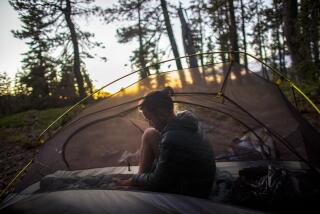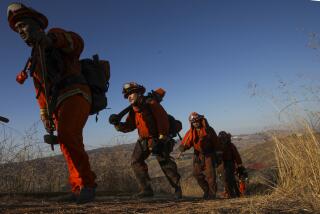Reserve Deputies of All Walks of Life Help Save Lives in the Mountains
On a cold, starry night, a banker, a fireman and a county official, all equipped with guns, ropes and radios, had just disappeared down the face of a remote dam in Malibu Creek State Park when their mock exercise turned into the real thing.
“Looks like we’ve got a real rescue,” said Chuck Pode, a Ventura County official who spends much of his free time climbing the Santa Monica Mountains in search of lost hikers and injured motorists whose cars have run into ravines.
Abandoning the rock-filled backpacks that were to be the pretended victims in their practice session, Pode and fellow volunteers Carmel Davis, a Bank of America officer, and Tom Murphy, an off-duty Culver City fireman, hustled back to the dirt road where a park ranger’s truck waited for them.
The three are reserve deputies with the Malibu Mountain Rescue Team of the Los Angeles County Sheriff’s Department, trained in law enforcement and mountaineering and available for emergency duty day or night, all for $1 a year--before taxes.
When the emergency call came in just after 8 p.m. on a Thursday in December, six members of the volunteer group had just finished the first leg of a training mission, designed to test their skills in finding a lost or injured hiker in darkness.
Now the test was real, one of nearly 70 rescue operations the 18-member group carried out in 1985.
Tossing their equipment into the bed of their pickup truck, they sped off at twice the speed limit, yellow light flashing and siren screaming, along Mulholland Highway to Kanan Dume Road.
There, John Karagavoorian, a young man in a T-shirt, said he had left four fellow Pepperdine University seniors somewhere in the hills after their four-wheel-drive vehicle ran into a ditch.
One of them, a 21-year-old woman who had been fasting for three days, began feeling faint, so Karagavoorian ran ahead to look for help. All he knew was that he had left the group where a narrow dirt fire road crossed a small stream and that it had taken him 45 minutes of running and walking to reach the highway.
About 10 p.m. they found the vehicle, but not the missing students. Trackers said later that leaving the car was the stranded group’s major mistake. If they had stayed with the vehicle, rescuers said, they would have been found hours sooner.
It was near a stream, with the temperature hovering around freezing, that the searchers found the missing party at 3:30 a.m., cold and sore but not seriously hurt. They all walked out before dawn.
The operation, though longer than most, was typical of the rescue squad’s duties, using techniques of mountain men and Indian scouts along with the latest technology.
They pinpointed the hikers’ location with a “big ear,” audio dishes used by TV networks to listen in on signals during football games.
11 Fatalities Last Year
“During the busy season a couple of months ago we were out 12 times in 15 days,” said Murphy, a resident of Newbury Park in Ventura County whose job with the Culver City Fire Department allows him free time for rescue work during the week.
Last year’s operations involved 79 victims, 11 of whom were fatalities.
“People in Los Angeles have a way of mixing drugs and alcohol with the great outdoors, with unfortunate results,” said Timothy Fives, a squad member who works as public information officer for College of the Canyons in Valencia.
Volunteers are not expected to leave their jobs to respond to an emergency call, but the squad has enough members with varying working hours to field at least a third of its members whenever a call comes in.
Members of the team keep their uniforms in the back of their vehicles, along with climbing ropes and rescue gear.
With routine training, weekend patrols and unpredictable emergency calls that can last all night, the squad requires a commitment that averages 56 hours a month. Why do they do it?
“It gives you a purpose for your extracurricular activities,” said Davis, who lives in Pacific Palisades. “Just hiking wasn’t enough.”
The regimen goes far beyond hiking. Applicants must pass a grueling selection and training process that eliminates 60% to 70% of them.
Written, Oral Exams
They must pass written and oral examinations, health and physical stress tests, a lie detector test and background check identical to the one for regular deputies. Then there is a five-month training course at the sheriff’s academy that runs 15 hours a week.
In addition, the training includes homework, target practice and physical workouts, all of which can be useful when the volunteers are called on for crowd control during fires, or, occasionally, to help with a felony arrest or car chase.
But that is only the beginning. The rescue training starts once the academy is finished. This includes rock-climbing, rappelling, first aid, helicopter tactics and map-reading skills.
Lengthy Training
Many volunteers also take a 125-hour course to become emergency medical technicians.
Veterans say it can take as long as two years before a rookie is seasoned enough to handle all assignments.
The Malibu team recently became affiliated with the Mountain Rescue Assn., a nationwide group, by passing a series of mountaineering tests.
According to Capt. Mark Squiers, commander of the Malibu sheriff’s office, it would cost about $40,000 a month to field a similar number of deputies for search-and-rescue duties in the station’s 200-square-mile area.
The symbolic pay of $1 a year means that the volunteers are covered by workers’ compensation for injuries and that the county is responsible in case of any legal action.
More to Read
Sign up for Essential California
The most important California stories and recommendations in your inbox every morning.
You may occasionally receive promotional content from the Los Angeles Times.










